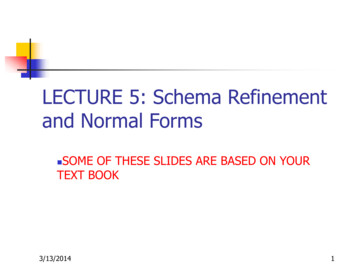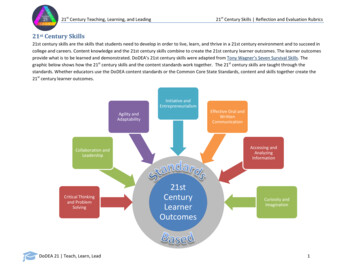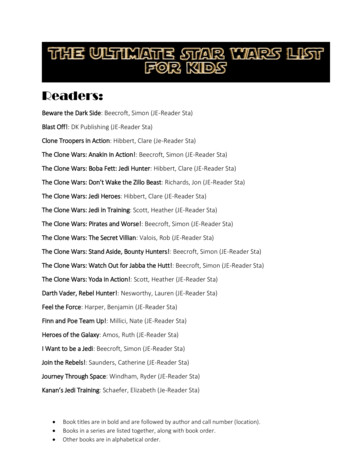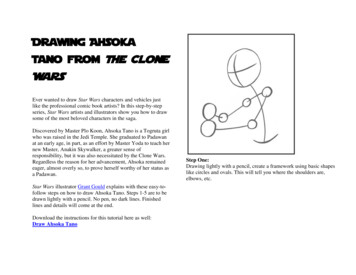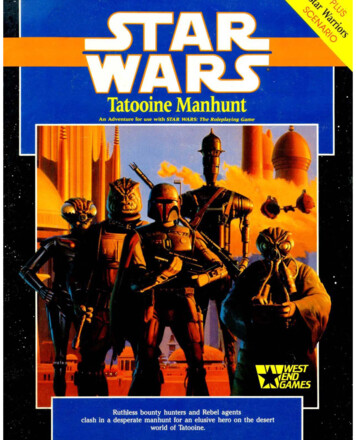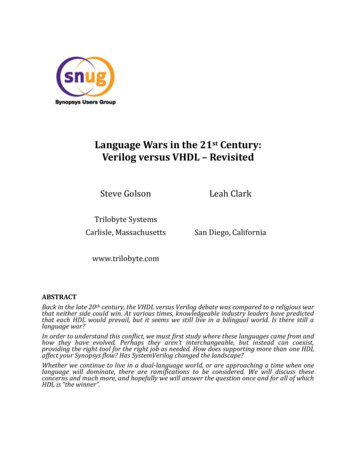
Transcription
Language Wars in the 21st Century:Verilog versus VHDL – RevisitedSteve GolsonLeah ClarkTrilobyte SystemsCarlisle, MassachusettsSan Diego, Californiawww.trilobyte.comABSTRACTBack in the late 20th century, the VHDL versus Verilog debate was compared to a religious warthat neither side could win. At various times, knowledgeable industry leaders have predictedthat each HDL would prevail, but it seems we still live in a bilingual world. Is there still alanguage war?In order to understand this conflict, we must first study where these languages came from andhow they have evolved. Perhaps they aren’t interchangeable, but instead can coexist,providing the right tool for the right job as needed. How does supporting more than one HDLaffect your Synopsys flow? Has SystemVerilog changed the landscape?Whether we continue to live in a dual-language world, or are approaching a time when onelanguage will dominate, there are ramifications to be considered. We will discuss theseconcerns and much more, and hopefully we will answer the question once and for all of whichHDL is “the winner”.
SNUG 2016Table of Contents1. Introduction . 42. A Brief History of Hardware Description Languages . 42.1 Early HDLs . 42.2 History of VHDL . 52.3 History of Verilog . 52.4 Language Wars in the Early 1990s . 62.5 Language Wars in the Late 1990s . 73. HDLs in the 21st Century . 93.1 C for Hardware Design . 93.2 The Rise of Verification Languages. 93.3 Verilog and SystemVerilog . 93.4 VHDL . 104. Languages in Today’s Flows . 104.1 HDL versus RTL . 104.2 How Many HDLs Do We Have Today? Two, Three, More?. 104.3 Some Language Quirks. 114.4 Writing Mixed RTL . 114.5 Training . 124.6 Pros and Cons of Using Multiple HDLs for RTL . 124.7 Maintaining Mixed RTL. 135. Implementation Challenges of Mixed Language Designs . 135.1 Reading in the RTL . 145.2 Synthesis and Physical Synthesis . 145.3 Logic Equivalence Checking. 155.4 DFT Tools . 155.5 Homegrown Tools . 165.6 And More . 165.7 You May Never Have Noticed Any of This Yet . 166. Verification Challenges . 176.1 Training – Revisited . 176.2 VHDL-2008 . 186.3 Verification IP . 18Page 2Language Wars in the 21st Century: Verilog versus VHDL – Revisited
SNUG 20167. EDA Infrastructure . 187.1 Coding Styles in General . 187.2 Support for New Features . 197.3 Case Study: Formality. 197.4 Case Study: Verific . 208. Conclusions and Recommendations . 208.1 And the Winner Is . 239. Acknowledgements . 2310. References . 24Page 3Language Wars in the 21st Century: Verilog versus VHDL – Revisited
SNUG 20161. IntroductionTwo hardware description languages—Verilog and VHDL—have become established as theindustry-standard starting point for large-scale digital logic synthesis [1].But why two languages? Wouldn’t one be enough?And most critically: How does the need to support more than one language affect your design flow?The answer to this riddle is critically important to every design engineer, verification engineer, andengineering manager. Come with us as we search to find the answer! Along the way we will explorethe history of HDLs, examine the intricacies of your current design flows, and discuss ourrecommendations for the future.2. A Brief History of Hardware Description LanguagesWhat is a hardware description language (HDL) and how is it used?In 1977, G. J. Lipovski gave this simple definition: “ a hardware description language is a variationof a programming language tuned to the overall needs of describing hardware [2].”In 1979, W. M. vanCleemput [3] listed the major applications of HDLs as: Description of the behavior and/or structure of a system as a means for accuratelycommunicating design details between designers and end users.As the input to a system level simulator.As the input to an automatic hardware compiler.As the input to a formal verification system.Amazingly, decades later these comments still hold true.2.1 Early HDLsIn his 1940 master’s thesis, Claude Shannon introduced a method for describing circuit behaviorusing Boolean algebra, manipulating these equations into their simplest form, and thensynthesizing the corresponding relay switching circuits [4].In a 1946 report, John von Neumann used a symbolic notation to describe the operations(i.e., instruction set) of the IAS computer [5].Irving S. Reed in 1952 proved that Boolean algebraic equations can be physically realized aselectronic circuits, and recommended “ in the initial synthesis [design] of a digital computer it isdesirable to concentrate one’s attention on the abstract model of the digital computer1 [6].” By1956, Reed extended this work into what he called a “register transfer language” to describe thedesign of a digital computer [7]. This is arguably the first true HDL, as it included the concepts oftiming and clocks.Research and development into hardware description languages continued through the 1960s. A1974 survey listed over fifty HDLs from all over the world2 [8].Or in modern terms, don’t rush to gates!If you really must know, in the USA they were AHPL, APDL, APL, CASD, CASSANDRE, CDL, DDL, DSDL, FST, ISP, LALSD, LDT, LOGAL,LOTIS, MDL, PMS, RTL, RTS I, RTS II, SDL, SDL II, VDL. In Canada: CDL, SDL, DDL, NEDELA. In France: COSEQ, SISEQ, CASSANDRE. In WestGermany: RTS I, RTS II, RTS III, ERES, AHPL. In Italy: CDL, ATLAS, DDS. In Japan: LDS, LORDS, DAIL 68, TBM, ADL. In Great Britain: REDAP50, FLOG, CALL, DA70, SIMBOL, CDL, ASM, HILO, LOGOS, ARTHUR.12Page 4Language Wars in the 21st Century: Verilog versus VHDL – Revisited
SNUG 2016Confronted with such a proliferation of languages, in 1973 an international group of researchersattempted to consolidate existing HDLs into a standard language. This CONLAN project (named forCONsensus LANguage) was formalized into a working group in 1975. Their initial results werepublished in 1980 [9] followed by a more complete report in 1983 [10].2.2 History of VHDLThe U.S. Department of Defense (DoD) began its ten-year VHSIC (Very High Speed IntegratedCircuit) program in 1979 to address specific military needs in microelectronics [11]. As part of thisproject, it was thought that a broad-based standard HDL should be created to allow transfer ofdesign data and descriptions independent of any given design tool or database, yet be machinereadable [12]. This new language was to be named VHDL (VHSIC Hardware Description Language).Following a workshop held in the summer of 1981, the VHDL development contract began in 1983and was awarded to a team from Intermetrics, IBM, and Texas Instruments. One major requirementwas to use Ada constructs wherever possible [13]. VHDL was heavily influenced by CONLAN [14].TI-HDL from Texas Instruments was used as a strawman language during the initial definition ofVHDL [15].The intention was to make VHDL a standard language, and mandate its use for design anddescription of DoD hardware [13]. This standardization process began in 1986 using VHDLversion 7.2 as the baseline specification [16]. Several more iterations followed, culminating in IEEEStandard 1076-1987 [17].In September 1988, MIL-STD-454L was issued by the U.S. Department of Defense [18]. Requirement64 of MIL-STD-454L stated that all ASICs designed after September 1988 “shall be documented3 bymeans of structural and behavioral VHDL descriptions.” In 1992, VHDL became a U.S. governmentwide standard when Federal Information Processing Standard 172 (FIPS Pub 172) was issued [19].2.3 History of VerilogVerilog was originally a proprietary verification/simulation product from Gateway DesignAutomation. Phil Moorby working with Chi-Lai Huang developed the language specification duringthe month of December 1983. Work on the logic simulator continued during 1984, and the first salewas in early 1985 [20].Moorby’s previous work with HILO-2 [21] was a major inspiration for the Verilog language, withinfluence also from C, Pascal, and especially occam [14]. Original goals for the language were tosupport logic simulation, fault simulation, and logic synthesis. The simulator supported min-maxstatic and dynamic timing analysis [20].By 1987, Moorby had written an even faster logic simulator called Verilog-XL, which boasted gatelevel simulation speeds approaching that of hardware accelerators. Verilog-XL was a landmarkproduct in EDA, rapidly gaining market share in an industry where there were several competingdigital simulators. In addition to greater simulation speed, Verilog-XL boasted greater design-sizecapacity than its competitors. It featured a single, integrated language for modeling both the designand the testbench, plus the ability for end users to extend the language using Verilog’sProgramming Language Interface (PLI). Furthermore, Gateway actively and successfully courtedASIC vendors to use Verilog-XL as their timing signoff “golden simulator.” At the request of theseNote the requirement is for documentation not design. Many suppliers took advantage of this and created their design using othermethods (sometimes even other HDLs), and then relied on automated translation tools to generate the required VHDL “documentation.”3Page 5Language Wars in the 21st Century: Verilog versus VHDL – Revisited
SNUG 2016vendors, Gateway implemented several Verilog language enhancements to support accurate gatelevel timing, including pin-to-pin path delays and a standardized method for back-annotation [22].Due to Verilog being a proprietary language, Gateway could easily add the features that ASICvendors wanted, and do it quickly without the multi-year process of IEEE standardization.Although Verilog remained proprietary to Gateway, multiple companies licensed the language touse for ASIC cell simulation libraries as well as logic synthesis tools.In late 1989, Gateway was acquired by Cadence, which continued to sell Verilog-XL and otherVerilog tools obtained from Gateway [27].2.4 Language Wars in the Early 1990sBy the late 1980s the stage was set for what became known as the “language wars,” pitting Verilogversus VHDL.VHDL became popular with many users and EDA tool vendors because it was an IEEE standard andthus could be used with no royalty cost. Also US military suppliers were required to document theirdesigns using VHDL.However, early VHDL tools revealed inconsistencies and ambiguities in the 1987 standard, and in1991 the IEEE was forced to issue an unusual “Standards Interpretation” document [23]. Differentvendors had dissimilar interpretations of the standard, and this became a source of frustration forearly VHDL users [19].In 1988 the 1st VHDL Users Group meeting was held as a “birds-of-a-feather” session at DAC (DesignAutomation Conference). In the fall of 1988, an independent VHDL Users Group meeting was held,and semiannual meetings continued afterwards. In 1991, the organization VHDL International (VI)was founded and the conference was renamed VIUF (VHDL International Users Forum) [24].Meanwhile, Verilog continued to gain popularity with ASIC vendors who settled on Verilog-XL astheir “golden simulator” for timing verification (i.e., signoff). Verilog-XL offered a standard timingback-annotation procedure, whereas VHDL specified no such standard, thus each VHDL simulatorvendor used a different scheme [25].Synopsys licensed the Verilog language from Gateway (later Cadence), and in 1988 introduced itsLogic Compiler synthesis tool (soon renamed Design Compiler) [26]. By 1989, eight ASIC vendorssupported Design Compiler. By the summer of 1991, 27 ASIC vendors supported the Synopsyssynthesis tool, with 20 using Design Compiler at their own design centers [27]. Despite its early useof Verilog, Synopsys became a strong advocate for VHDL, perhaps because they offered a VHDLsimulator product but no Verilog simulator.In 1990, Cadence released the Verilog language to a newly formed nonprofit organization calledOpen Verilog International (OVI). The language definition entered the public domain and becameavailable to any vendor [22]. Starting in 1992, OVI began sponsoring the annual InternationalVerilog Conference (IVC). By 1992 there were about six U.S. companies who had announced or weredeveloping Verilog simulators [14]. In 1993, Verilog had twice the market share of VHDL [28].Nevertheless, by 1992, VHDL was enjoying widespread support. The 1993 IEEE VHDL standardofficially clarified the language ambiguities and introduced a few new features [29]. The problem ofinconsistent ASIC library models and different back-annotation methodologies across vendors wasfinally solved with the VITAL (VHDL Initiative Towards ASIC Libraries) IEEE standard issued in1995 [30].Joe Costello (CEO of Cadence) gave the keynote speech at the spring 1992 VIUF. He suggested thatOVI and VI work together and called for an end to the “HDL wars.” Furthermore he said thatPage 6Language Wars in the 21st Century: Verilog versus VHDL – Revisited
SNUG 2016Cadence was 100% committed to supporting both languages [27].The conventional wisdom of the early 1990s was that VHDL was going to win the “language wars”[81]. Industry analysts such as Ron Collett and Gary Smith predicted VHDL revenues wouldovertake Verilog in 1992–1994 [31]. A 1992 survey by MJ Associates predicted Verilog usage woulddecline, and that VHDL would command 75% of the market by 1997 [32]. Even Phil Moorby,Verilog’s inventor and the first Cadence Fellow, by 1992 was working on a VHDL simulator [14].Consider Figure 1, which shows an n-gram plot of how often the words VHDL and Verilog appear inthe Google Books corpus [33] for the years 1980–1995. Clearly many more VHDL than Verilogbooks are published in the 1980s and early 1990s.0.00008%Percentage of all gure 1: n-gram plot of VHDL and Verilog appearances in Google Books corpus2.5 Language Wars in the Late 1990sDespite the predictions, Verilog continued to prosper.In 1992, OVI began working towards establishing Verilog as an IEEE standard. The working groupheld its first meeting in late 1993 [34].By 1995, every major CAD vendor was supporting Verilog. Simulators, synthesizers, and tools wereavailable from over 40 companies [28].At the Synopsys Users Group meeting (SNUG) in early 1995, John Cooley hosted a 90-minute designcontest. Using either Verilog or VHDL the contestants were to create a gate netlist for the fastestfully-synchronous loadable 9-bit increment-by-3 decrement-by-5 up/down counter that generatedeven parity, carry and borrow. This contest unexpectedly became fodder for the HDL languagewars, as eight of the nine Verilog designers completed their netlists, while none of the five expertVHDL designers even got to gates [35]. This triggered enormous discussion about whether theseresults were indicative of the relative quality and usefulness of the two HDLs [36]. Was thisevidence that Verilog really was better than VHDL?Also in early 1995, DoD standard MIL-STD-454L was replaced and the use of VHDL was no longerPage 7Language Wars in the 21st Century: Verilog versus VHDL – Revisited
SNUG 2016mandated. Instead, the new wording stated that ASIC designs “should be documented” by means ofVHDL [37]. By 1997 even this suggestion was removed [38].In December 1995, Verilog became an IEEE standard [34].The fall 1995 VHDL International User Forum (VIUF) had a difficult time attracting attendees [39].In contrast, the International Verilog Conference (IVC) continued to have strong growth. For 1996,the two HDL conferences (VIUF for VHDL, and IVC for Verilog) announced they would co-locate[40]. By 1998, they were combined into a true joint conference [41], and in 1999 it was renamedthe 8th Annual HDL Conference and Exhibition (HDLCon) [42]. In 2003, the name changed again toDesign and Verification Conference and Exhibition (DVCon) [43]. In 2014, the conference expandedinternationally adding DVCon India and DVCon Europe [44][45].In 1997 Synopsys acquired Viewlogic, which had itself acquired Chronologic in 1994 along with itsgroundbreaking compiled Verilog simulator VCS (Verilog Compiler Simulator) [46]. Now with anindustry-leading Verilog simulator of their own, Synopsys supported both languages across theirproduct line.In February 2000, the two language groups VHDL International (VI) and Open Verilog International(OVI) merged to form Accellera [47].The 2001 IEEE Verilog standard added many new features to the language, several of which wereinspired by similar VHDL capabilities [48].Figure 2 again shows the n-gram plot of how often the words VHDL and Verilog appear in theGoogle Books corpus, now including data extending out to 2000. The number of occurrences ofVHDL declined after 1995, while Verilog continued to grow.0.00008%0.00007%Percentage of all 0.00002%0.00001%0.00000%19801985199019952000Figure 2: n-gram plot of VHDL and Verilog appearances in Google Books corpusWas VHDL popularity really declining? Had Verilog won the language war?Page 8Language Wars in the 21st Century: Verilog versus VHDL – Revisited
SNUG 20163. HDLs in the 21st Century3.1 C for Hardware DesignBeginning in the late 1990s, several proposals and tools were introduced using C with classlibraries for hardware design, for example, SystemC and SpecC. These were touted as allowing RTLmodeling as well as higher levels of abstraction and system-level modeling. Furthermore, theexpectation is that these tools would run on inexpensive commodity servers. Similarly, Java wassuggested as a hardware design language [22].Hardware designers were uniformly unimpressed [49] and eventually these C tools wereredirected towards system architects and transaction-level modeling.3.2 The Rise of Verification LanguagesAs chips began to exceed one million gates in size, the use of HDLs such as Verilog and VHDL forverification (i.e., writing test benches) became unwieldy. A more modern object-oriented approachwas required [50].As a result, a number of hardware verification languages were introduced, for example e and Vera.Also, other system-level tools such as Rosetta and PSL make their appearance [1].3.3 Verilog and SystemVerilogIn 1997 Co-Design Automation was founded with the intent of developing a new simulator and anentirely new language suitable for hardware design, verification, and software development. Ratherthan create a new language, Co-Design soon decided to enhance and extend Verilog. By 1999, thenew language Superlog was introduced, along with a simulator SYSTEMSIM as well as a translatorSYSTEMEX that output traditional Verilog [22].By early 2001, the EDA world settled into two groups: one group advocating the C SystemC, andthe other group advocating, “evolve Verilog” into Superlog. Work began by Accellera to standardizeSuperlog4. In May 2002, this new language extension was approved and became known asSystemVerilog5 [22].Accellera continued its work on the language, culminating in SystemVerilog 3.1a in 2004. Furtherstandards work was undertaken by the IEEE resulting in the “IEEE Standard for SystemVerilog—Unified Hardware Design, Specification, and Verification Language” approved in November 2005[51]. A corresponding update to the Verilog standard maintained consistency of the base Veriloglanguage with the new SystemVerilog standard [52].In 2009, the two standards were merged into a single standard and a single language:SystemVerilog [53]. Further enhancements and errata corrections resulted in the most recentversion in 2012 [54].Synopsys acquired Co-Design in late 2002 [22]. Synopsys became a major advocate forSystemVerilog. At DVCon ’03 Synopsys CEO Aart de Geus gave the keynote address and stronglysupported SystemVerilog as the one language for the future. Legacy Verilog code is compatible withThe Accellera committee originally called this next generation language Verilog [50].The first release of the SystemVerilog standard by Accellera was given the version number "3.0". This made it clear that SystemVerilogwas the third generation of the Verilog language (IEEE 1364-1995 being the first generation of Verilog or 1.0, and 1364-2001 being thesecond generation, or 2.0) [50].45Page 9Language Wars in the 21st Century: Verilog versus VHDL – Revisited
SNUG 2016SystemVerilog and can still be used moving forward, but the implication was that VHDL had nofuture [55]. This caused much consternation and spirited discussion in the industry [56][57]. WasVHDL dead?3.4 VHDLBetween 1993 and 2008, the IEEE VHDL standard did not change significantly. In 2000, protectedtypes were introduced [58], and in 2002 only minor changes were made [59].In sharp contrast, the 2008 VHDL standard [60] added a large number of enhancements andimprovements, making VHDL more suitable as a verification language, and notably incorporatingmany features first seen in Verilog and SystemVerilog. For example: external names, force andrelease, generate enhancements, sensitivity list updates, and the VHPI interface to C [61]. Manysyntax changes were included to reduce VHDL’s verbosity [62]. Despite the lack of object-orientedcapabilities, new packages were developed that greatly increase VHDL’s usefulness as a verificationlanguage [63].4. Languages in Today’s FlowsWhy do we care about languages in flows? It turns out that which language you choose can have avery large impact on your design flow, for both simulation and synthesis. Different vendors havedifferent levels of support for VHDL and SystemVerilog. It is important to be aware of what theseare when choosing a language (if you should be so lucky as to get a choice), and especially whenchoosing a full set of tools to support your flow. Choosing the right path from the beginning caneliminate a lot of problems further down the road, and you can only do that with the rightinformation.Before we can talk about flows, we need to get some definitions out of the way.4.1 HDL versus RTLA lot of people use these two terms interchangeably, but they do not mean the same thing. HDLstands for Hardware Description Language, which is a full programming language. It is highlyconfigurable, and allows coding of abstract structures. For example, dynamically linked lists oranything with “dynamic” or “variable” in the name. RTL is a coding style called Register TransferLevel, which can be written in an HDL. But RTL is not a language, it is just a coding style, and whenusing it you are limited to a well-defined subset of the HDL’s capabilities.In this paper, we casually talk about “Verilog” and “VHDL” as if they mean the same thing toeveryone, but they don’t. An implementation engineer is going to code things very differently froma verification engineer.Another way to distinguish between HDL and RTL is to consider what tool you are targeting.Simulators are really smart and can process many different coding styles, regardless of the HDLbeing used. However, not all EDA tools are that smart, and it is important to code to the “dumbest”tool in your arsenal. No one cares how compact, elegant, or sleek your code is if it breaks the tools!4.2 How Many HDLs Do We Have Today? Two, Three, More?First of all, let’s clear something up. A lot of people refer to Verilog and SystemVerilog as twodifferent languages, but they are not. Hopefully reading about the history in Section 3. of this papermade it clear that SystemVerilog is an evolution of earlier Verilog specifications. From this point on,we will use “SystemVerilog” to refer to the modern language, and “Verilog-200*” or sometimes justPage 10Language Wars in the 21st Century: Verilog versus VHDL – Revisited
SNUG 2016“Verilog” to refer to prior versions of the language.Given that, how many HDLs do we have to work with? The answer, as with so many things, is “itdepends”. To explain why, we need to divide our chip design flow into two parts: Implementationand Verification. We’ll go into detail about each of these in the next sections. But first, let’s talkabout the “Big Two” languages for a bit longer.4.3 Some Language QuirksNo language is perfect, and VHDL and Verilog are no exception. Shannon Hilbert created a niceonline chart of VHDL and Verilog pros and cons [77] and here are some of the ones that stand out:VHDL Has no ifdef construct — requires another complete architectureDoes not support hierarchical referencing (although this was added in VHDL-2008)File reading is order-dependentMore likely to require passing in generics (parameters) which can be error-proneCase insensitivity can causes issuesIs a strongly-typed language, wh
Synopsys licensed the Verilog language from Gateway (later Cadence), and in 1988 introduced its Logic Compiler synthesis tool (soon renamed Design Compiler) [26]. By 1989, eight ASIC vendors supported Design Compiler. By the summer of 1991, 27 ASIC vendors supported the Synopsys



